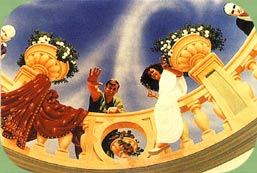

“All art work takes you into another world but a lot
of it is seen as just that: ‘art work.’
What I am trying
to achieve is the window, so you are not seeing the piece
as art but as a separate reality, and for a moment you
enter that reality.
"From an early age I was in awe of everything :
the
whole goddam shebang.
The more I look, the more mysterious it becomes.
The more you see — not in the sense of trying to work it out, to project some meaning
on anything, because that is exhausting....
You see the
world in the same way but instead of your understanding
going out to it
— labeling something as being a certain
color or a certain configuration — you let the world in
more.
“The still point is something I had always looked at
as a passive observer of my whole life
but I had never
fully understood it till I met Osho.
He presented very simple, fundamental truths about existence that I was
aware of,
and I am sure others are,
held them up to me
and said,
‘This is what you are looking at.’
The whole existence is right there in front of our
eyes all the time in its purity,
without any interpretations,
but we can’t see it because we have interpretations,
our own egos and our minds which distort and label.
“Osho takes what is there and puts it into words and
into stories through which we can see more clearly.
He has a knack of fooling our minds, our judgmental minds,
to introduce us to a reality which the mind can’t see and
which is beyond the mind.”
§

“People call the way I paint lazy and unmotivated; I
call it effortless. It has to be effortless.
Effort is needed but not a striving, tense effort of wanting to
achieve something. Not a goal-oriented ‘art piece.’
“The preparation — mixing paint and so on — takes
up a certain amount of my energy. The rest of the time I
become what I am painting. It is a meditation for me. I
paint first from the feeling of what I want and then the
vision comes.
“I use different elements from my life.
There might be deep water from one experience in my life mixed with
water from another pond I have sat by.
So everything has an emotional connection for me.
“I go for what I see as the essence of this
existence. All that exists is neither good nor bad.
It has everything in it : it is a balance, a harmony.
Violence exists in this world, yes, but so does its
opposite.
There is a dynamic happening between them.
That’s what the world is — a dynamic flow — and if it
weren’t, it wouldn’t exist.
"And there is a still point around which this all revolves.
“I find silence in nature.
So what I am doing is connecting the two worlds.
My art is a focus, a window between the two worlds of ‘reality’
or between the real and the surreal.

...Back for more Buddhas of Suburbia
Back to the top
|

![]()
